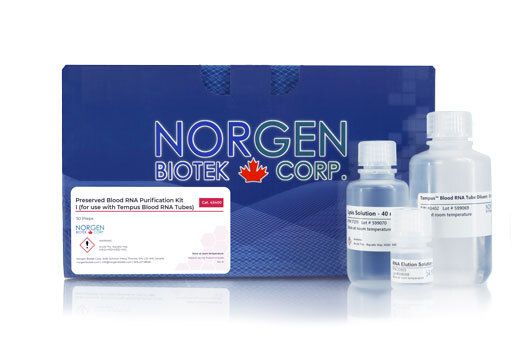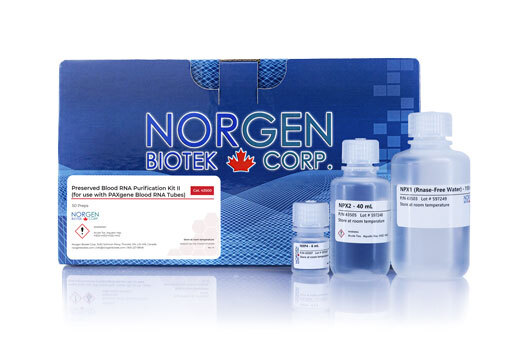Preserved Blood RNA Purification Kit I (for use with Tempus Blood RNA Tubes)
Rapid isolation and purification of total RNA from blood that has been preserved using Tempus™ Blood RNA Tubes

For research use only and NOT intended for in vitro diagnostics.
Preserved Blood RNA Purification Kit I (for use with Tempus Blood RNA Tubes)
Rapid isolation and purification of total RNA from blood that has been preserved using Tempus™ Blood RNA Tubes
Register today to receive an exclusive 15% off* on your first order.
Features and Benefits
- Compatible with Tempus™ Blood RNA Tubes
- Isolate true total RNA including siRNA and microRNA
- No phenol extractions
- Purify high-quality RNA in 30 minutes
- Purified RNA is suitable for a variety of downstream applications, including Small RNA Sequencing. Find out more information on Norgen's NGS services
- Purification is based on spin column chromatography that uses Norgen’s proprietary resin separation matrix
Norgen’s Preserved Blood RNA Purification Kit I provides a rapid method for the isolation and purification of total RNA from blood that has been preserved using Tempus™ Blood RNA Tubes*. The kit purifies all sizes of RNA, from large mRNA and ribosomal RNA down to microRNA (miRNA) and small interfering RNA (siRNA). The RNA is preferentially purified from other cellular components such as proteins, without the use of phenol or chloroform.
Purification is based on spin column chromatography using Norgen’s proprietary resin as the separation matrix. Norgen’s proprietary resin provides superior affinity to the full size range of RNA molecules, resulting in large and small RNA (miRNA) purification with better linearity and sensitivity. The purified RNA is of the highest integrity, and can be used in a number of downstream applications including real time RT-PCR, RT-PCR, Northern blotting, RNase protection and primer extension, expression profiling, miRNA cloning and amplification and Next Generation Sequencing.
* Tempus™ is a registered trademark of Life Technologies. Tempus™ Blood RNA Tubes are not provided.
Details
Supporting Data
Figure 1. Isolation of High Quality Total RNA. Total RNA was isolated in duplicate from 3 mL hamster blood samples collected into Tempus™ RNA Blood Tubes using Norgen’s Preserved Blood RNA Purification Kit I and was subsequently analyzed using an Agilent BioAnalzyer. Panel A shows the electropherogram from the Agilent Bioanalyzer, where the y axis represents fluorescence units and the x axis represents the runtime (s). The bands of the 18S and 28S rRNA fragments are clearly visible and the RNA integrity number score is 9.0. Panel B demonstrates the gel banding pattern of the RNA species purified from hamster blood. Abundant blood transcripts such as the globin mRNAs constitute the additional bands to the two major rRNA bands.
Figure 2. Isolate a Diversity of RNA Species, from large mRNA to microRNA. Total RNA was isolated in duplicate from 3 mL hamster blood samples collected into Tempus™ RNA Blood Tubes using Norgen’s Preserved Blood RNA Purification Kit I and was subsequently used as the template in a RT-qPCR reaction for the detection of various sized RNA. All sizes of RNA were successfully amplified including large RNA (Beta-Actin = green), small RNA, such as the 5S rRNA (blue) and microRNA, miR-21 (red), indicating both the size diversity of the purified RNA, as well as the high quality of the RNA. No template control is shown in yellow.
Figure 3. High Yield of a Diversity of RNA Species. Norgen's Preserved Blood RNA Purification Kit I (for use with Tempus™ Blood RNA Tubes) effectively recovers all sizes of RNA from large mRNA to small RNA, including microRNAs. Total RNA was isolated from equal amounts of goat blood collected in Tempus™ Blood RNA Tubes followed by RNA isolation using Norgen's Preserved Blood RNA Purification Kit I and a competitor's kit. The purified RNA was then used as the template in a RT-qPCR for detecting the beta-Actin gene (Left Panel) and for detecting miR-21 (Right Panel). In both graphs the blue lines correspond to Norgen isolated-RNA and the red lines correspond to competitor-isolated RNA. As it can be seen, Norgen's kit isolated higher yields of microRNA, as indicated by the lower Ct values of the blue lines (Right Panel). Also, Norgen's kit successfully isolated similar amount of large RNA to that of the competitor’s kit (Lower Panel) indicating the full diversity of RNA species isolated.
|
Kit Specifications
|
|
|
Maximum Column Binding Capacity
|
50 μg
|
| Maximum Column Loading Volume |
650 μL
|
| Size of RNA Purified |
All sizes, including
small RNA (< 200 nt) |
| Time to Complete 10 Purifications |
20 - 30 minutes
|
| Average Yield |
5 - 25 μg per 3 mL
preserved human blood |
Storage Conditions and Product Stability
All solutions should be kept tightly sealed and stored at room temperature. This kit is stable for 2 years after the date of shipment.
| Component | Cat. 43400 (50 preps) |
|---|---|
| Tempus™ Blood RNA Tube Diluent | 2 x 90 mL |
| Lysis Solution | 40 mL |
| Wash Solution | 22 mL |
| Elution Solution | 6 mL |
| Mini Spin Columns | 50 |
| Collection Tubes | 50 |
| Elution Tubes (1.7 mL) | 50 |
| Product Insert | 1 |
Documentation
FAQs
Spin Column
- Incomplete lysis of blood.
Ensure that the appropriate amount of Lysis Solution was used.
- An alternative elution solution was used.
It is recommended that the Elution Solution supplied with this kit be used for maximum RNA recovery.
- Ethanol was not added to the lysate.
Ensure that the appropriate amount of ethanol is added to the lysate before binding to the column.
- Ethanol was not added to the Wash Solution.
Ensure that 50 mL of 95% ethanol is added to the supplied Wash Solution prior to use.
- Insufficient centrifugation time and speed when pelleting the stabilized blood RNA before column purification.
Centrifuge the samples for at least 30 minutes or longer at 4,000 x g or higher. The RNA pellet was lost during decanting Pour off the supernatant slowly and carefully.
- Insufficient solubilization of blood.
Ensure that the appropriate amount of Lysis Buffer was used.
- Centrifuge temperature is too low.
Ensure that the centrifuge remains at room temperature throughout the procedure. Temperatures below 15°C may cause precipitates to form that can cause the columns to clog.
- RNase contamination.
RNases may be introduced during the use of the kit. Ensure proper procedures are followed when working with RNA. Please refer to “Working with RNA” at the beginning of the protocol's user guide.
- Procedure not performed quickly enough.
In order to maintain the integrity of the RNA, it is important that the procedure be performed quickly.
- Improper storage of the purified RNA.
For short term storage RNA samples may be stored at -20°C for a few days. It is recommended that samples be stored at -70°C for longer term storage.
- RNA was not washed 3 times with the provided Wash Solution A.
Traces of salt from the binding step may remain in the sample if the well is not washed 3 times with Wash Solution A. Salt may interfere with downstream applications, and thus must be washed from the well.
- Ethanol carryover.
Ensure that the dry spin under Column Wash in the centrifugation protocol or the extended vacuum in the vacuum protocol is performed in order to remove traces of ethanol prior to elution. Ethanol is known to interfere with many downstream applications.
Citations
| Title | Genetic analysis of the blood transcriptome of young healthy pigs to improve disease resilience |
| Citation | Genetics Selection Evolution volume 2023. |
| Authors | Kyu-Sang Lim, Jian Cheng, Christopher Tuggle, Michael Dyck, PigGen Canada, Frederic Fortin, John Harding, Graham Plastow & Jack Dekkers |
| Title | Identification and control for the effects of bioinformatic globin depletion on human RNA-seq differential expression analysis |
| Citation | Scientific Reports 2023. |
| Authors | Dylan Sheerin, Francisco Lakay, Hanif Esmail, Craig Kinnear, Bianca Sansom, Brigitte Glanzmann, Robert J. Wilkinson, Matthew E. Ritchie & Anna K. Coussens |
| Title | A Globin Blocker to Increase Sequencing Efficiency for QuantSeq 3' mRNA-Seq in Porcine Blood |
| Citation | Animal Industry Report 2018. |
| Authors | Lim, K. S., Dong, Q., Moll, P., Vitkovska, J., Wiktorin, G., Bannister, S., ... & Dekkers, J. (2018) |
| Title | Circulating microRNA as a marker for predicting liver disease progression in patients with chronic hepatitis B |
| Citation | SciELO Analytics 2017. |
| Authors | Riazalhosseini, B., Mohamed, R., Apalasamy, Y. D., Langmia, I. M., & Mohamed, Z. (2017). |
| Title | The LIFE Child study: a population-based perinatal and pediatric cohort in Germany |
| Citation | European Journal of Epidemiology 2017. |
| Authors | Poulain, T., Baber, R., Vogel, M., Pietzner, D., Kirsten, T., Jurkutat, A., ... & Fuchs, M |
| Title | Comparison of blood RNA isolation methods from samples stabilized in Tempus tubes and stored at a large human biobank |
| Citation | BMC Research Notes 2016. |
| Authors | Aarem, J., Brunborg, G., Aas, K. K., Harbak, K., Taipale, M. M., Magnus, P., ... & Duale, N |
| Title | Differences in Whole Blood Gene Expression Associated with Infection Time-Course and Extent of Fetal Mortality in a Reproductive Model of Type 2 Porcine Reproductive and Respiratory Syndrome Virus (PRRSV) Infection |
| Citation | PLoS One 2016. |
| Authors | Wilkinson, J. M., Ladinig, A., Bao, H., Kommadath, A., Stothard, P., Lunney, J. K., ... & Plastow, G. S |
| Title | Evaluation of Existing Methods for Human Blood mRNA Isolation and Analysis for Large Studies |
| Citation | PLoS One 2016. |
| Authors | Meyer, A., Paroni, F., Günther, K., Dharmadhikari, G., Ahrens, W., Kelm, S., & Maedler, K |
| Title | Post-weaning blood transcriptomic differences between Yorkshire pigs divergently selected for residual feed intake |
| Citation | BMC Genomics 2016. |
| Authors | Haibo Liu1 , Yet T. Nguyen2,3, Dan Nettleton2 , Jack C. M. Dekkers4 and Christopher K. Tuggle |
| Title | DICER1 and microRNA regulation in post-traumatic stress disorder with comorbid depression |
| Citation | Nature Communication 2015. |
| Authors | Wingo, A. P., Almli, L. M., Stevens, J. J., Klengel, T., Uddin, M., Li, Y., ... & Smith, A. K |

